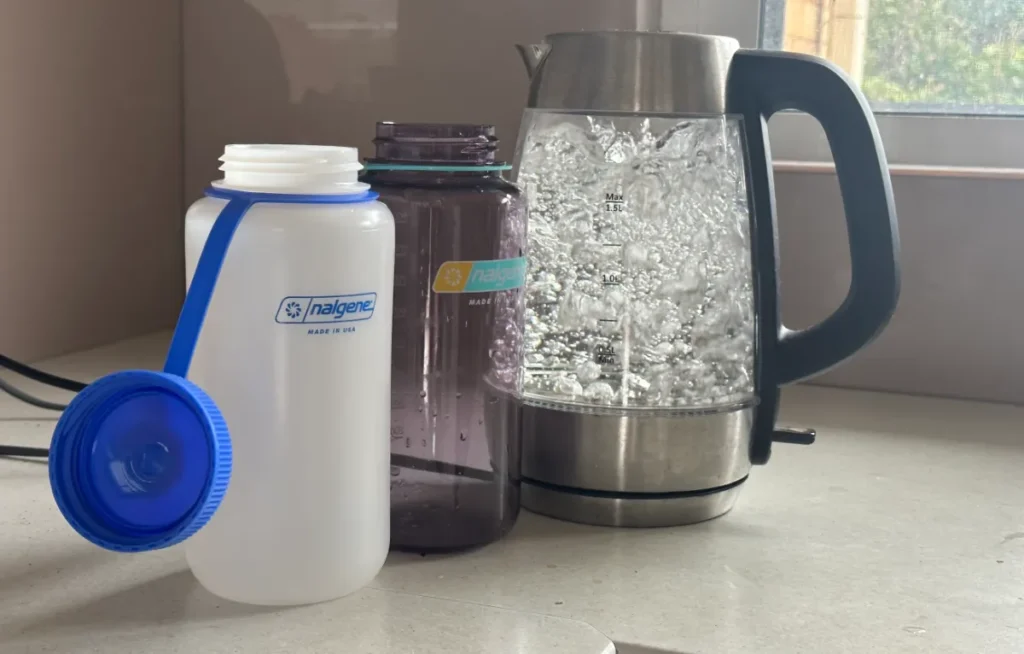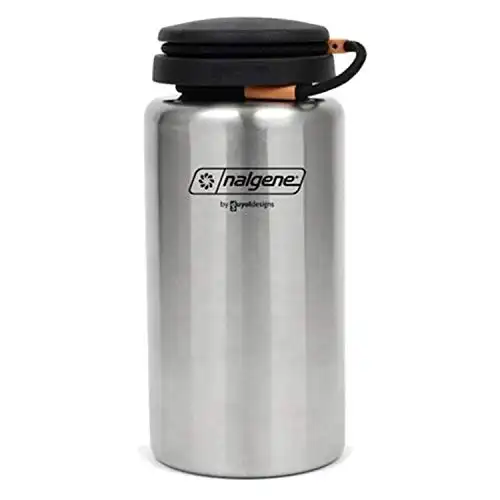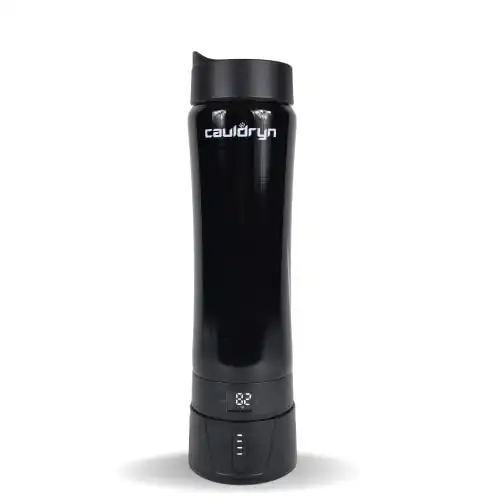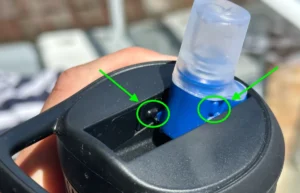Using my Nalgene as a hot water bottle has helped keep me warm on a cold night backpacking more times than I can count.
It’s one of my favorite Nalgene hacks and is pretty quick and easy to do, but there are a few simple steps I take to make sure my Nalgene doesn't melt and doesn't burn me. So how exactly do you use your Nalgene Bottle as a hot water bottle?
Making a hot water bottle with your Nalgene is easy:
- Bring the water to a rolling boil.
- Leave water to cool slightly
- Pour it into your Nalgene bottle and seal the lid.
- Test the surface of the bottle with the back of your hand. If it’s too hot, wrap it in a sweatshirt or some wool socks.
- Tuck the hot water bottle into your sleeping bag by your feet, between your legs, or against your stomach.
- Enjoy the warmth.
Nalgene Bottles make great hot water bottles because they can handle high temperatures without melting or deforming and they almost never leak. It's really great to have an everyday water bottle that can double as a hot water bottle to keep you cold at night.
I can’t imagine cold weather camping without one.
1. Choose The Right Nalgene
A stainless steel Nalgene Bottle works best as a hot water bottle, both because it transfer heat through it easily but also because you don't have to worry about plastic chemical leaching at all.
It's my first choice when it comes to making a Nalgene hot water bottle — though the Tritan plastic water bottles work well too.
Unlike most stainless steel water bottles, stainless steel Nalgenes are single-walled which allows heat to transfer through the bottle’s walls to keep you warm.
Made from single wall surgical grade 316 (18/10) stainless steel and featuring the same size threads as the regular Nalgene widemouth this is the perfect bottle for those wanting the lifetime warranty and durability of a Nalgene without the plastic.
Comes with a rope pack loop lid attachment.
Hard plastic Nalgene Bottles can be used too. Nalgene bottles are made from Tritan plastic which is a hard, durable clear plastic that can handle high temperatures.
You know you have this type of Nalgene bottle if it's see through (not translucent) and has the words “BPA FREE” stamped on the bottom of the bottle.

These Nalgene bottles are fine to put boiling water in. They can get up to 201ºF/93ºC on a regular basis without any long term issues or damage and it takes temperatures over 230ºF/110ºC to soften the plastic where it's at risk of being deformed.
So boiling water, or hot water, won't damage these bottles.
Just keep in mind, hot water can make toxins leach from the bottle into the water it contains. This isn't a huge issue though. My recommendation is just to not drink from the bottle again until you’ve washed it and refilled with fresh water.
So use hot water for your hot water bottle but do not drink this water once it's cooled. After you've finished using your Nalgene as a hot water bottle empty the bottle, wash it (or rinse it) and then refill with fresh cold drinking water.
Ultralite HDPE bottles can be used as hot water bottles if you’re in a pinch, but they are going to get a lot softer than the regular Nalgene bottles and have a higher risk of deforming so you need to be more careful.

When I poured boiling water in my Nalgene Ultralite bottle within just a few seconds it became softer to touch and within 30-60 seconds it would noticeably deform when I gave it a light squeeze with my fingers.
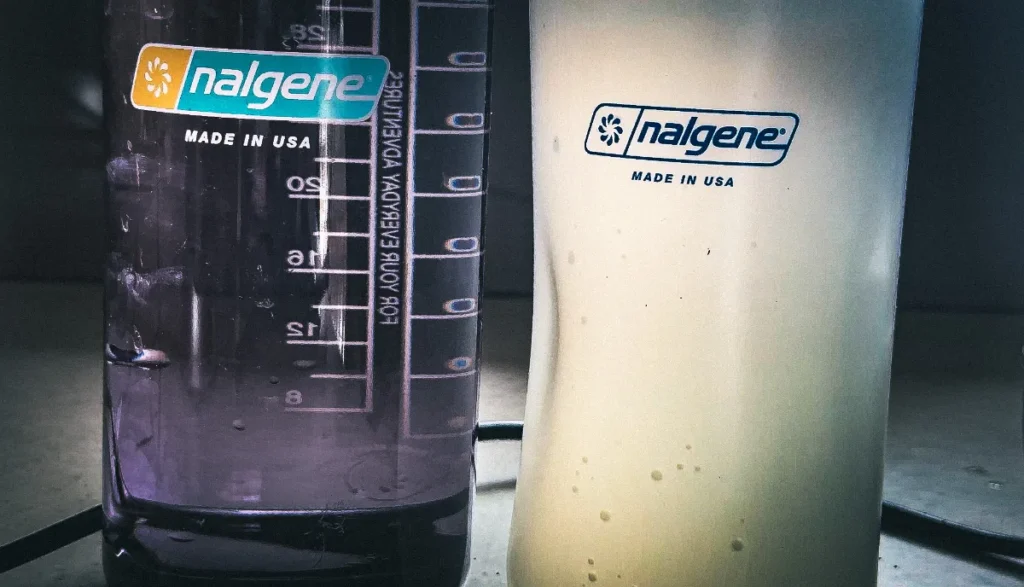
The scary thing was it would stay deformed for a few seconds after I took my fingers away.
It eventually went back to it's original shape but you should definitely be careful with putting boiling water in these bottles.
Just be sure to let the water cool down a bit before filling it. HDPE’s softening point is much lower than that of hard plastics, like Tritan. They will begin to soften around 153ºF/67ºC and completely melt at around 266ºF/130ºC.
If you fill these with boiling (or even very hot) water you will notice the bottle becomes dangerously soft. Be careful not to apply firm pressure to the bottle at this point or it could deform or leak.
2. Heat The Water
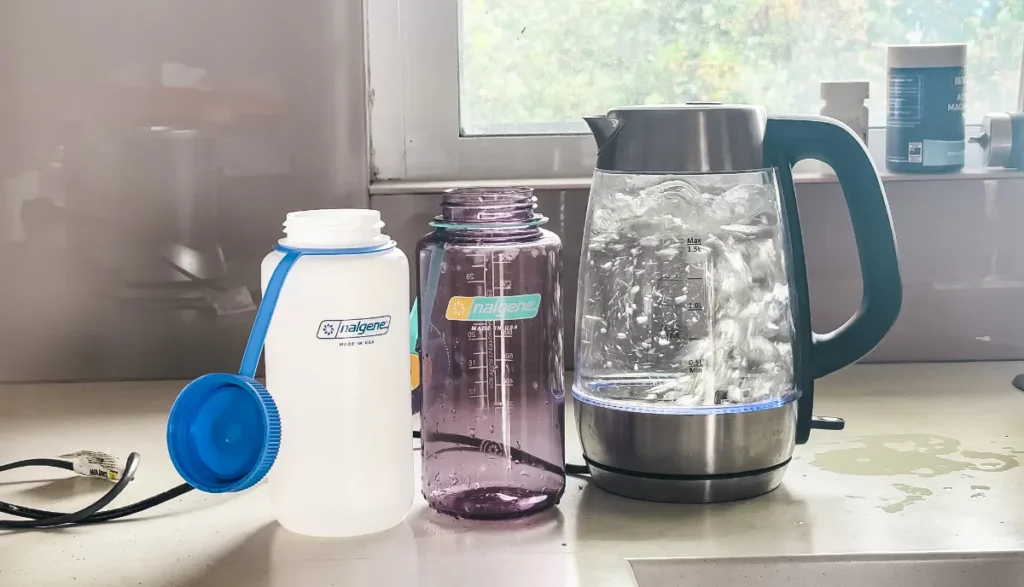
Bring the water to a rolling boil just before making your hot water bottle so it doesn’t have a chance to cool down too much.
Depending on the gear you have available, the best method to boil your water will vary.
If you’re car camping, an electric kettle or burner will do the trick. A really cool tool for easily boiling water on the go when you're backpacking is the Cauldryn battery heated coffee mug (at Amazon).
It can bring water from room temperature to a boil and can also keep coffee and tea hot for 10+ hours at a time. A great tool to have.
The Cauldryn features vacuum insulation and a long lasting battery that can keep your drinks hot for an incredible 10 hours of the go!
This is the only battery powered heated coffee mug that can actually bring water to a boil and be used for making coffee or even to heat up soup of cook freeze dried foods. This is an incredible product.
If you have a campfire, heating the water in a pot or kettle over the fire works great too.
When backpacking with limited gear, a canister stove is your best bet.
My SOTO WindMaster is the best all-around backpacking stove I’ve used. Though, if I’m concerned about minimizing the weight of my pack, the BRS-3000T still works well and is a lot lighter.
Compatible with gas mixtures such as butane, isobutane and propane. Shock resistant and ultra lightweight perfect for backpacking. Maintains a consistent output and can boil 2 cups of water in under 2.5 minutes, even in strong winds. Designed to support large pots this is one of the best stoves out there with an near perfect rating after thousands of reviews.
Whatever method you choose, water should never be boiled directly in your Nalgene Bottle.
I saw some people talking about throwing their Nalgene in a campfire or over the stove to boil water. DO NOT DO THIS!
Plastic bottles will melt and the surface of stainless steel bottles will become dangerously hot.
Boil your water separately then pour into your Nalgene.
3. Leave The Water To Cooler Slightly
While you can put fresh boiling water straight into your Nalgene bottle I prefer to wait a couple of minutes for the water to cool down from around 212ºF/100ºC down to around 176-194ºF/80-90ºC.
Regular Nalgene bottles have a max operating temperature of 201ºF/94ºC. This means you don't want to regularly exceed this temperature or it will cause stress and damage to your bottle.
So waiting until the water is below 194ºF/90ºC is a good idea. This should only take a minute or two after the water is boiled.
You can use a temperature gauge if you have one but I just tend to wait a couple of minutes then pour the water into my Nalgene.
4. Pour The Water Into Your Nalgene

Once the water’s ready, pour it (carefully) into your Nalgene Bottle. Secure the lid and flip the bottle upside down a few times to make sure it’s not leaking.
I always used a wide mouth Nalgene because it’s much easier to pour into than a narrow mouth bottle, but both would work fine.
5. Wrap Your Bottle (if necessary)
Wait a minute or so and test the temperature of the bottle with the back of your hand.
If it’s uncomfortably hot, wrap the bottle in a sweatshirt or a few wool socks so it doesn’t burn you. Wrapping up your Nalgene will also have the added benefit of helping it stay hot for longer.
If you don’t want to wrap it, you have two options.
Only bring the water to 160-180°F (71-82°C) instead of a rolling boil. It should be hot enough to provide some warmth but cool enough to be comfortable to the touch.
Or stick it in your sleeping bag for 20 or 30 minutes before hopping in. It’ll warm the inside of your bag a bit and the bottle should have cooled down enough to use without wrapping.
6. Tuck It Into Your Sleeping Bag Or Under Your Coat
Tuck the hot water bottle into your sleeping bag.
Putting it at the foot of your bag is good when it’s not super cold out. But on particularly cold nights, I’ll keep it between my legs or near my stomach for extra warmth (you may have heard it called a belly bottle or crotch bottle).
On particularly cold days, I’ll sometimes make a hot water bottle and stick it inside my jacket when I’m hiking as well.
Hot water bottles will stay hot for about an hour or two but will continue to provide some warmth for four to five hours. But it a really good sleeping bag and wrapped up in some sort of sweatshirt or sock it can still be warm when morning rolls around.
On extra cold nights you may need to hop out and remake your hot water bottle halfway through the night if it cools too much, though once I’m asleep I’m usually okay for the night.
Don’t Rely Too Much On A Hot Water Bottle
A hot water bottle can feel amazing on a cold night, but should never be relied on for warmth.
If you can’t comfortably make it through the night without one, you’re simply undergeared for the weather.
Before any camping or backpacking trip, check the forecast and be well prepared for temperatures to drop even lower than expected.
That means packing a sleeping bag and pad rated for the lowest temperatures you might face, layering well, and always sleeping in dry clothes.

